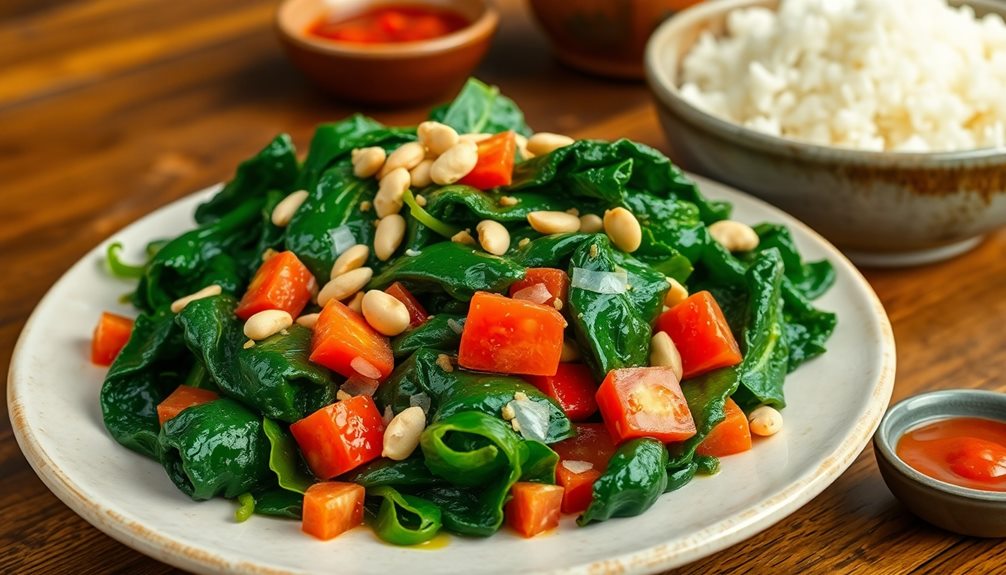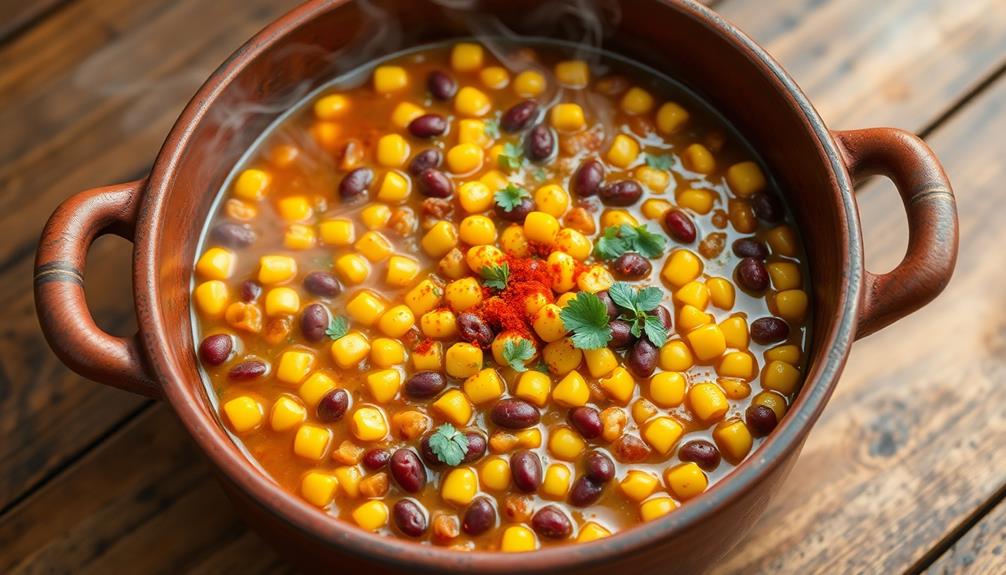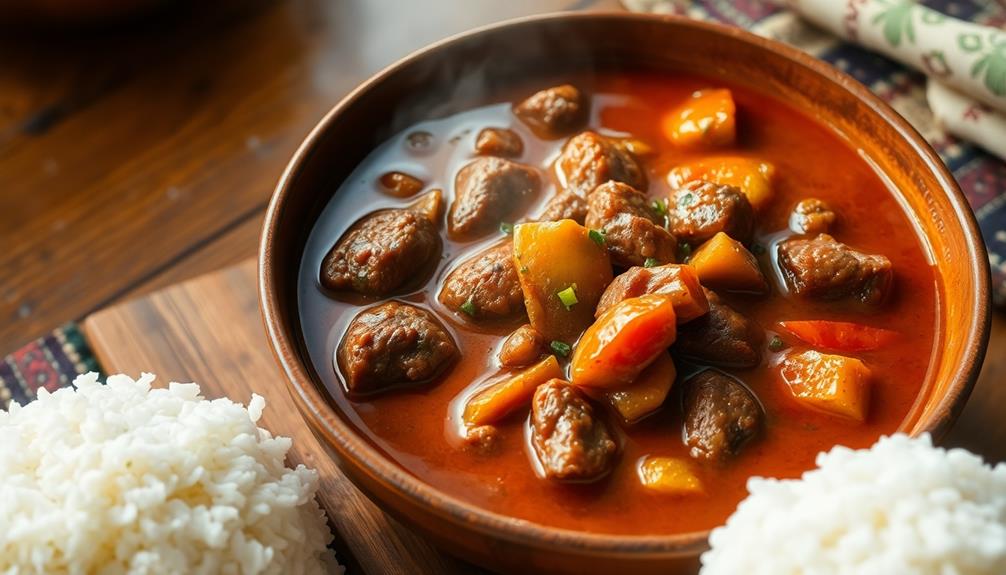African greens, like collard greens and kale, are both nutritious and delicious! To prepare them, you'll first wash and chop the greens. Then, sauté chopped onion and garlic in a pan until soft. Add the greens and season with salt, pepper, and a splash of lemon juice for brightness. Stir in coconut milk and let it simmer to create a creamy goodness. Serve these flavorful greens over rice or quinoa for a delightful meal. They're a perfect addition to family tables or gatherings, and there's so much more to discover about cooking these vibrant greens!
Key Takeaways
- African greens, such as collard greens and kale, are nutrient-dense, rich in vitamins A, C, and K, and low in calories.
- To prepare, wash and chop greens, then sauté with garlic and onion for enhanced flavor.
- Season with salt, pepper, paprika, and herbs, and add coconut milk for a creamy texture.
- Serve over rice or quinoa for a balanced meal, and consider garnishing with fresh herbs for added freshness.
- These versatile greens can be incorporated into various dishes, including soups, salads, and grain bowls, for nutritious meals.
History
When you delve into the history of African greens, you'll discover that these vibrant vegetables have been a staple in various cultures for centuries. People in Africa have grown and enjoyed greens like collard greens, amaranth, and kale for generations. These leafy treasures aren't just tasty; they're packed with nutrients that keep families strong and healthy.
In many African communities, greens are often grown in home gardens, making them easily accessible for cooking. Traditionally, they're combined with grains and proteins, creating delicious meals that bring families together.
You might be surprised to learn that these greens are celebrated for their importance in festivals and gatherings, symbolizing abundance and health.
As you explore different regions, you'll find unique ways people prepare and enjoy these greens, from spicy stews to simple sautéed dishes. The rich history of African greens reflects the creativity and resourcefulness of those who cultivate them.
It's exciting to think about how these vegetables connect cultures, families, and generations. So, as you learn more about African greens, remember their story—it's one of nourishment, tradition, and love shared around the dinner table.
Cooking Steps
To prepare delicious African greens, you'll want to gather your ingredients and get cooking without delay.
Start by washing your leafy greens thoroughly to remove any dirt. Next, chop them into bite-sized pieces. You'll also need some onion, garlic, and spices like salt and pepper to make the greens flavorful.
Now, heat a bit of oil in a large pan over medium heat. Add the chopped onion and garlic, cooking until they're soft and fragrant. This usually takes about 2-3 minutes.
Then, toss in your greens and stir them well. If they seem a bit dry, don't hesitate to add a splash of water or broth. Cover the pan and let them cook for about 5-7 minutes, stirring occasionally.
Once the greens are tender, season them with salt, pepper, and any other spices you like. Give everything a good stir, and your tasty African greens will be ready to serve!
Enjoy them as a side dish or mix them into your favorite meals. Remember, cooking is all about having fun, so don't be afraid to experiment with flavors!
Step 1. Wash and Prepare Greens
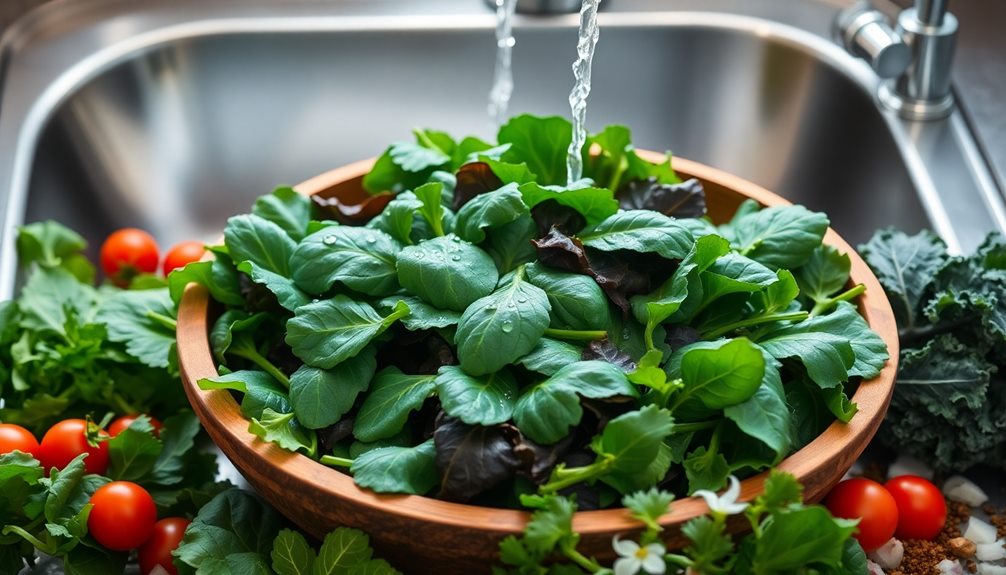
Start by rinsing your greens thoroughly under cool running water to remove any dirt or grit.
It's important to make sure your greens are clean, so give them a good shake in the water to help dislodge any stubborn bits of soil.
Once they're rinsed, place the greens in a colander or on a clean kitchen towel to drain.
Next, you'll want to chop them if they're large.
Grab a sharp knife and slice the greens into bite-sized pieces. This makes them easier to cook and eat later on.
If you're working with tougher leaves, like collard greens, you might want to remove the stems, as they can be a bit chewy.
After chopping, give your greens one last rinse to wash away any leftover bits of dirt.
Now, shake off the excess water or pat them dry with a towel.
You've done such a great job preparing your greens!
They're now clean, chopped, and ready for the next step in your delicious African greens recipe.
Trust me, you're going to love how they taste once you cook them!
Step 2. Sauté With Garlic and Onion
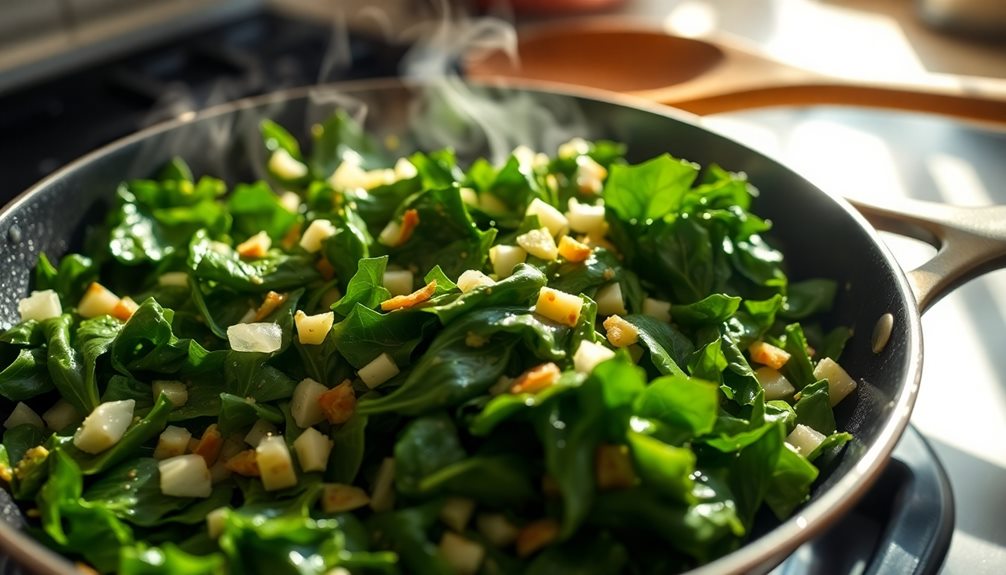
Sautéing garlic and onion creates a fragrant base that enhances the flavor of your greens. To start, gather your ingredients: fresh garlic and onion, along with a splash of oil. You can use olive oil, vegetable oil, or whatever you have handy.
Heat a pan over medium heat and add the oil. Once it's hot, toss in the chopped onion. Stir it around for about two minutes, letting it soften and turn a light golden color.
Next, add the minced garlic. It only takes a minute or so for garlic to release its wonderful aroma, so keep an eye on it! Stir frequently to prevent it from burning. You want that beautiful, fragrant mixture to blend perfectly.
Once the garlic and onion are ready, you can add your washed and prepared greens to the pan. The heat will help the greens wilt nicely, absorbing all those yummy flavors.
Step 3. Add Spices and Seasoning
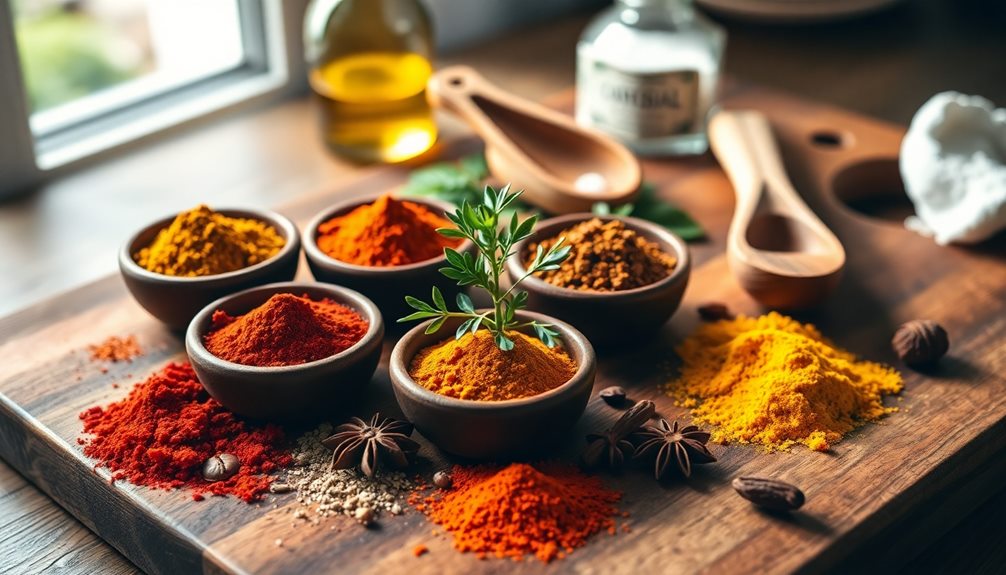
With the garlic and onion beautifully softened and fragrant, it's time to elevate your greens with spices and seasoning. Start by adding a pinch of salt and pepper. This simple step brings out the natural flavors of the greens.
Next, sprinkle in some paprika for a little kick and a warm color. You can also try adding a touch of cayenne pepper if you like things spicy!
Don't forget about the herbs! Toss in a teaspoon of dried thyme or oregano to give your dish a delightful aroma. If you have fresh herbs like cilantro or parsley, chop them up and add them at the end to keep their bright flavor.
If you want to mix things up, consider adding a splash of lemon juice or vinegar. This little zing balances the richness of the greens and spices, making every bite exciting.
Stir everything together and let it all cook for a few more minutes. You'll notice how the spices blend beautifully with the greens, creating a colorful and tasty dish.
The aroma will fill your kitchen, making everyone eager to dig in! Enjoy your flavorful creation!
Step 4. Stir in Coconut Milk
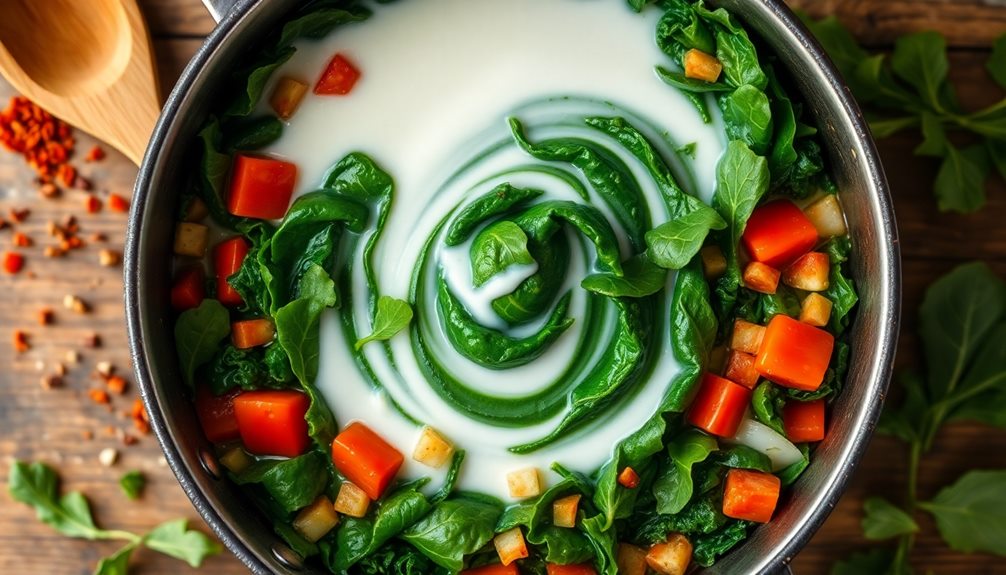
Now that your greens are seasoned to perfection, it's time to add a creamy touch with coconut milk. Grab a can of coconut milk and shake it well before you open it. This helps mix up the cream and liquid inside.
Pour the coconut milk into your pot, stirring it gently into the greens. The rich, creamy texture will make your dish even more delicious!
As you stir, watch the greens change color and become glossy. This step adds a wonderful tropical flavor that pairs beautifully with the spices you've used.
Let the mixture simmer for about five to ten minutes. This will allow the coconut milk to soak into the greens, making them tender and flavorful.
Don't forget to taste as you go! If you think it needs a little more seasoning, feel free to add a pinch of salt or a dash of pepper. You want every bite to be bursting with flavor!
Once it's all combined and heated through, you'll have a bowl of vibrant, creamy greens that's sure to impress everyone. Get ready for the next step, because this dish is getting even better!
Step 5. Serve With Rice or Quinoa
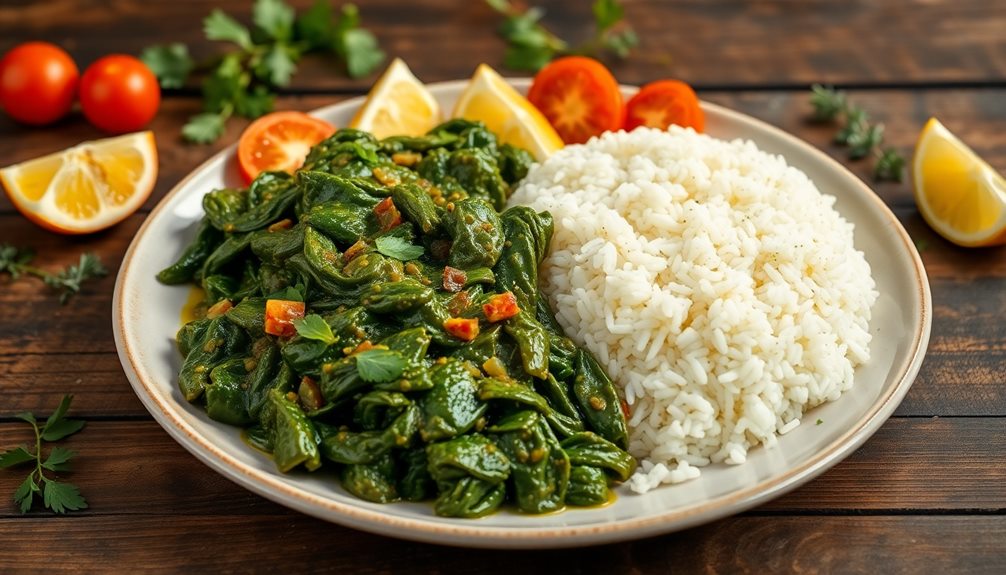
Once your creamy greens are simmered to perfection, it's time to complement them with a hearty base. You can choose rice or quinoa, both of which are nutritious and will make your meal even more delicious.
If you pick rice, start by rinsing one cup of it under cold water. This helps remove extra starch and keeps it fluffy. Then, boil two cups of water, add the rice, and let it simmer for about 18 minutes until it's tender and the water is absorbed.
If you prefer quinoa, rinse it too, just like rice. Use a ratio of one part quinoa to two parts water. Bring the water to a boil, add the quinoa, and reduce the heat. Let it simmer for about 15 minutes until it's light and fluffy.
Once your base is ready, serve the creamy greens over the rice or quinoa. This not only makes your plate colorful but also adds an amazing texture to each bite.
Enjoy the mix of flavors, and feel free to sprinkle some fresh herbs or nuts on top for an extra kick! Your healthy, hearty meal is now ready to be shared and savored!
Final Thoughts
African greens offer a delightful culinary experience that can transform any meal into a vibrant feast. These nutritious leafy greens aren't only packed with vitamins and minerals but also bring a unique flavor to your table.
When you try cooking them, you'll discover how easy it's to create a colorful dish that everyone will love. Additionally, incorporating these greens can enhance your meal's nutritional value, much like how educational toys stimulate cognitive growth in preschoolers.
Incorporating African greens into your meals is a fantastic way to explore new flavors while enjoying health benefits. You can sauté, steam, or stir-fry them, making them a perfect side dish or even a main course. These nutrient-packed greens are rich in vitamins and minerals, promoting overall well-being. Pair them with other traditional ingredients like African eggplant for a delightful, balanced meal. For more inspiration, explore African eggplant cooking ideas such as roasting, grilling, or incorporating them into stews for added texture and flavor.
Pair them with rice, quinoa, or your favorite protein for a complete meal.
Don't forget to experiment with spices and herbs to enhance their taste! Whether you're cooking for family or friends, these greens will surely impress. Plus, you'll feel great knowing you're serving something good for everyone.
Frequently Asked Questions
What Are the Health Benefits of African Greens?
You'll find that African greens are packed with vitamins, minerals, and antioxidants. They boost your immune system, enhance digestion, and support overall health. Incorporating them into your diet can really elevate your nutrient intake.
Can I Substitute African Greens With Other Leafy Greens?
Yes, you can substitute African greens with other leafy greens like kale, collard greens, or spinach. Just keep in mind that flavors and textures might differ, so adjust your cooking methods and seasonings accordingly.
How Do I Store Leftover African Greens?
To store leftover greens, cool them to room temperature, then place them in an airtight container. Keep them in the refrigerator, and they'll stay fresh for about three to five days. Enjoy them later!
Are African Greens Suitable for Vegan Diets?
Yes, African greens are perfect for vegan diets! They're packed with nutrients, and you can enjoy them in various dishes. Just make sure to prepare them without any animal products to keep it entirely plant-based.
Where Can I Buy African Greens?
You can buy African greens at local farmers' markets, specialty grocery stores, or international markets. If you can't find them nearby, consider ordering online from reputable sellers that focus on fresh produce.
